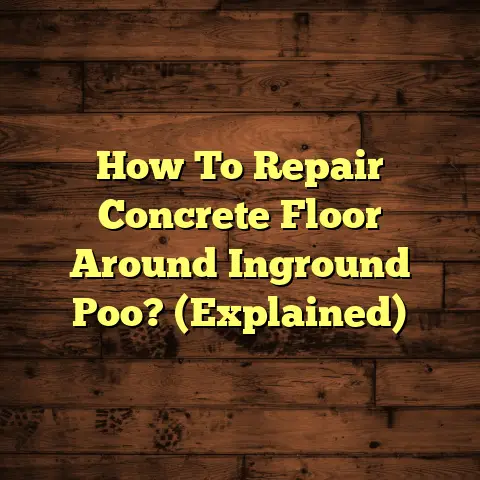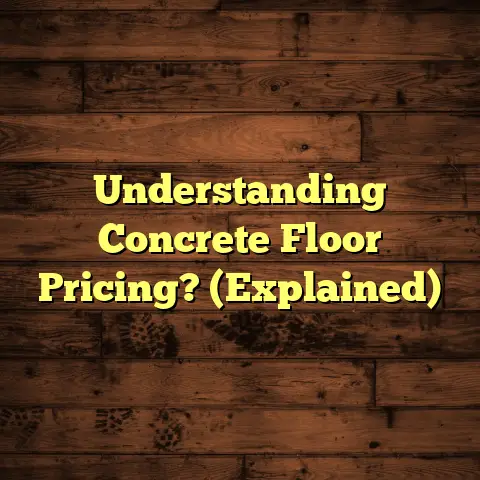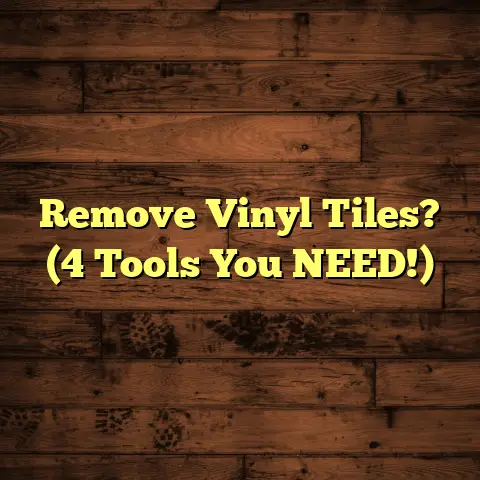Clean & Maintain Vinyl Floors: How To? (4 Mistakes!)
I’m talking about that smooth, stylish surface that pulls the whole room together.
More often than not these days, that’s vinyl flooring.
And let me tell you, as a flooring contractor for over 15 years, I’ve seen it all when it comes to vinyl floors – the good, the bad, and the downright ugly.
Vinyl’s become super popular, and for good reason.
It’s affordable, durable, and comes in a million different looks.
You can mimic hardwood, stone, tile – you name it!
But here’s the thing: even the best vinyl floor needs some TLC to stay looking its best.
That’s why I’m here to spill the beans on how to keep your vinyl floors sparkling, and more importantly, how to avoid the most common mistakes that can ruin them.
Trust me, a little know-how can save you a lot of headaches (and money!) down the road.
So, let’s dive in!
1. Understanding Vinyl Flooring
1.1 What is Vinyl Flooring?
Okay, let’s get down to basics. What exactly is vinyl flooring?
Well, it’s a synthetic flooring made from several layers of different materials.
Think of it like a delicious layered cake, but for your floor!
The main components are usually PVC (polyvinyl chloride) and plasticizers.
These give it that flexibility and durability we all love.
Now, there are a few main types of vinyl flooring you should know about:
-
Sheet Vinyl: This comes in large rolls, usually 6 or 12 feet wide, and it’s great for covering large areas with minimal seams. It’s the most water-resistant option, making it perfect for bathrooms and kitchens.
-
Vinyl Tile: These are individual tiles, usually square or rectangular, that are glued down to the subfloor. They offer more design flexibility and are easier to replace if one gets damaged.
-
Luxury Vinyl (LV): This is the top-of-the-line stuff. It’s thicker and more durable than standard vinyl, and it often features realistic textures and patterns that mimic natural materials. You’ll find it in two main forms:
- Luxury Vinyl Tile (LVT): Individual tiles that offer high-end aesthetics and durability.
- Luxury Vinyl Plank (LVP): Long, narrow planks that look just like hardwood floors.
Each type has its own pros and cons, but they all share the same basic composition and benefits: affordability, water resistance, and easy maintenance.
1.2 Aesthetic Versatility
One of the things I love most about vinyl flooring is its versatility.
Seriously, you can achieve almost any look you want without breaking the bank.
Want the warmth of hardwood without the hefty price tag?
LVP is your answer.
Dreaming of a sleek, modern kitchen with stone-look tiles?
Vinyl tile has got you covered.
I’ve seen vinyl floors that perfectly mimic everything from rustic reclaimed wood to elegant marble, and honestly, sometimes it’s hard to tell the difference!
The possibilities are endless.
And it’s not just about mimicking natural materials.
Vinyl flooring also comes in a huge range of colors, patterns, and textures.
You can find everything from bold geometric designs to subtle, neutral tones.
Here’s a quick rundown of some popular design trends I’ve seen lately:
-
Wood-look LVP in warm, natural tones: Think oak, maple, and hickory. These add a cozy and inviting feel to any room.
-
Gray-toned LVP or LVT: Gray is still a super popular neutral, and it works well with a variety of décor styles.
-
Large-format vinyl tiles that mimic concrete or stone: These create a modern and minimalist look.
-
Patterned vinyl tiles in bathrooms and kitchens: Think geometric designs, Moroccan-inspired patterns, and even vintage-inspired motifs.
-
Waterproof vinyl flooring: According to Home Depot, waterproof vinyl flooring is up to 100% waterproof, making it a great choice for moisture-prone rooms.
No matter your personal style, there’s a vinyl floor out there that will fit your needs and budget.
2. The Importance of Cleaning and Maintenance
Alright, so you’ve got your beautiful new vinyl floors installed.
Now what?
Well, just like any other investment, you need to take care of it if you want it to last.
Regular cleaning and maintenance are crucial for preserving the visual appeal and extending the lifespan of your vinyl flooring.
Trust me, neglecting your floors can lead to some serious problems down the road.
2.1 Visual Appeal and Longevity
Think about it: your floors are one of the first things people notice when they walk into a room.
If they’re covered in dirt, scuff marks, and stains, it’s not exactly a great first impression, is it?
Regular cleaning helps to remove dirt, dust, and debris that can dull the finish and make your floors look dingy.
It also prevents stains from setting in and becoming permanent.
And let’s not forget about wear and tear.
Over time, dirt and grit can act like sandpaper, scratching and damaging the surface of your vinyl flooring.
This can lead to fading, discoloration, and even cracking.
By keeping your floors clean and well-maintained, you can prevent these problems and keep them looking their best for years to come.
I’ve seen vinyl floors that look almost brand new after 10 or 15 years, simply because the homeowners took the time to clean them regularly.
2.2 Health Considerations
Okay, so keeping your floors looking good is important, but what about your health?
Turns out, clean floors can also contribute to a healthier home environment.
Dust, dirt, and allergens can accumulate on your floors, triggering allergies and asthma symptoms.
Regular cleaning helps to remove these irritants, improving indoor air quality and making it easier to breathe.
According to the EPA, indoor air pollutants can be two to five times higher than outdoor levels.
Keeping your floors clean is a simple way to reduce your exposure to these pollutants.
And let’s not forget about germs and bacteria.
Floors can be a breeding ground for all sorts of nasty stuff, especially in high-traffic areas like kitchens and bathrooms.
Regular cleaning with a disinfectant cleaner can help to kill these germs and prevent the spread of illness.
So, cleaning your vinyl floors isn’t just about aesthetics – it’s also about protecting your health and well-being.
3. Essential Cleaning Techniques for Vinyl Floors
Alright, now that we know why cleaning is important, let’s talk about how to do it right.
Here’s a breakdown of the essential cleaning techniques for vinyl floors:
3.1 Daily and Weekly Cleaning Routines
The key to keeping your vinyl floors looking great is consistency.
Establishing a daily and weekly cleaning routine will help to prevent dirt and grime from building up and becoming difficult to remove.
Here’s my recommended routine:
-
Daily:
- Sweep or vacuum: Use a soft-bristled broom or a vacuum cleaner with a floor brush attachment to remove loose dirt, dust, and pet hair. Pay special attention to high-traffic areas and corners.
- Spot clean spills: Wipe up spills immediately with a damp cloth or paper towel. The longer a spill sits, the more likely it is to stain.
-
Weekly:
- Mop: Mop your floors with a damp mop and a mild cleaning solution. I recommend using a pH-neutral cleaner specifically designed for vinyl floors. Avoid using harsh chemicals or abrasive cleaners, as these can damage the finish.
- Rinse: After mopping, rinse your floors with clean water to remove any residue from the cleaning solution.
- Dry: Dry your floors with a clean, dry towel or microfiber cloth to prevent water spots.
Here are some of my favorite cleaning tools and solutions for vinyl floors:
- Soft-bristled broom: This is essential for sweeping up loose dirt and debris.
- Vacuum cleaner with a floor brush attachment: This is great for removing pet hair and dirt from hard-to-reach areas.
- Damp mop: Use a microfiber mop or a sponge mop that can be wrung out thoroughly.
- pH-neutral vinyl floor cleaner: Look for a cleaner that is specifically designed for vinyl floors and is labeled as pH-neutral.
- Microfiber cloths: These are great for wiping up spills and drying your floors.
3.2 Deep Cleaning Methods
Sometimes, your regular cleaning routine just isn’t enough.
When you’re dealing with tough stains, scuff marks, or a buildup of grime, you need to break out the big guns and do a deep clean.
Here are a few deep cleaning methods I recommend:
-
Steam cleaning: Steam cleaning is a great way to remove dirt and grime without using harsh chemicals. The hot steam loosens dirt and kills bacteria, leaving your floors clean and sanitized. Be sure to use a steam cleaner that is specifically designed for hard floors and follow the manufacturer’s instructions carefully.
-
Baking soda paste: For tough stains, try making a paste of baking soda and water. Apply the paste to the stain, let it sit for a few minutes, and then gently scrub with a soft cloth or sponge. Rinse with clean water and dry thoroughly.
-
Vinegar solution: Vinegar is a natural cleaner that can be used to remove dirt and grime from vinyl floors. Mix 1/2 cup of white vinegar with 1 gallon of warm water and use this solution to mop your floors. Rinse with clean water and dry thoroughly.
-
Specialized vinyl floor cleaners: There are many specialized vinyl floor cleaners on the market that are designed to remove tough stains and restore shine. Be sure to choose a cleaner that is specifically designed for your type of vinyl flooring and follow the manufacturer’s instructions carefully.
Here are some tips for deep cleaning your vinyl floors:
- Test in an inconspicuous area: Before using any new cleaning product or method, test it in an inconspicuous area to make sure it doesn’t damage the floor.
- Don’t over-wet the floor: Use a damp mop or cloth and avoid saturating the floor with water.
- Rinse thoroughly: After cleaning, rinse your floors with clean water to remove any residue from the cleaning solution.
- Dry thoroughly: Dry your floors with a clean, dry towel or microfiber cloth to prevent water spots.
4. Common Mistakes in Vinyl Floor Maintenance
Okay, so now you know how to clean your vinyl floors the right way.
But what about the wrong way?
I’ve seen so many homeowners make these common mistakes that can damage their floors and shorten their lifespan.
Here are the top 4 mistakes to avoid:
4.1 Mistake #1: Using Harsh Chemicals
This is probably the biggest mistake I see people make.
They think that if a little cleaner is good, a lot must be better, right?
Wrong!
Harsh chemicals like bleach, ammonia, and abrasive cleaners can strip the finish off your vinyl flooring, leaving it dull, discolored, and vulnerable to scratches.
Why are harsh chemicals so bad for vinyl floors?
- They can damage the protective layer: Most vinyl floors have a protective wear layer that helps to resist scratches, stains, and wear. Harsh chemicals can break down this layer, making your floors more susceptible to damage.
- They can dull the finish: Harsh chemicals can strip the shine off your vinyl floors, leaving them looking dull and lifeless.
- They can discolor the floor: Some chemicals can react with the vinyl and cause discoloration or fading.
What are some safe alternatives to harsh chemicals?
- pH-neutral vinyl floor cleaner: As I mentioned earlier, this is the best option for cleaning vinyl floors.
- Vinegar solution: A mixture of 1/2 cup of white vinegar and 1 gallon of warm water is a safe and effective cleaner.
- Baking soda paste: This is great for removing tough stains.
Here’s a table comparing the pH levels of common cleaning products:
| Cleaning Product | pH Level |
|---|---|
| pH-Neutral Floor Cleaner | 7 |
| White Vinegar | 2.5 |
| Baking Soda | 8.3 |
| Ammonia | 11 |
| Bleach | 13 |
Note: pH levels range from 0 (most acidic) to 14 (most alkaline). A pH of 7 is neutral.
As you can see, ammonia and bleach are highly alkaline, making them too harsh for vinyl floors.
4.2 Mistake #2: Neglecting to Sweep or Vacuum Regularly
This may seem like a no-brainer, but you’d be surprised how many people skip this step.
Sweeping or vacuuming regularly is essential for preventing dirt and grit from building up on your floors and scratching the surface.
Think of it like this: dirt and grit are like tiny little sandpaper particles.
Every time you walk on your floors, you’re grinding those particles into the surface, causing scratches and wear.
How often should you sweep or vacuum?
- Daily: If you have pets or kids, you should sweep or vacuum daily.
- Every other day: If you don’t have pets or kids, you can probably get away with sweeping or vacuuming every other day.
- At least once a week: Even if you don’t see any dirt, you should still sweep or vacuum at least once a week to remove any accumulated dust and debris.
What type of broom or vacuum should you use?
- Soft-bristled broom: This is the best option for sweeping vinyl floors.
- Vacuum cleaner with a floor brush attachment: This is great for removing pet hair and dirt from hard-to-reach areas. Avoid using a vacuum cleaner with a beater bar, as this can scratch the surface of your floors.
4.3 Mistake #3: Over-Wetting the Floors
Water and vinyl don’t always mix well.
While vinyl is water-resistant, it’s not completely waterproof.
If you over-wet your floors, water can seep into the seams and edges, causing warping, buckling, and even mold growth.
How can you avoid over-wetting your floors?
- Use a damp mop: Wring out your mop thoroughly before mopping your floors. You want the mop to be damp, not soaking wet.
- Don’t pour water directly onto the floor: Instead, dip your mop into a bucket of water and wring it out.
- Dry spills immediately: Wipe up spills as soon as they happen to prevent water from seeping into the seams.
- Ensure proper ventilation: Open windows or turn on a fan to help your floors dry quickly after mopping.
What if you accidentally over-wet your floors?
- Dry the area immediately: Use a clean, dry towel to soak up as much water as possible.
- Use a fan or dehumidifier: Place a fan or dehumidifier in the room to help dry the floors quickly.
- Check for signs of water damage: Look for signs of warping, buckling, or mold growth. If you see any of these signs, contact a flooring professional immediately.
4.4 Mistake #4: Failing to Use Furniture Pads
This is another simple but important step that many people overlook.
Failing to use furniture pads under your furniture can lead to scratches, dents, and other damage to your vinyl floors.
Every time you move your furniture, you’re dragging it across the floor, causing scratches and wear.
Heavy furniture can also dent the floor, especially if it’s not properly supported.
What type of furniture pads should you use?
- Felt pads: These are great for protecting your floors from scratches.
- Rubber pads: These are good for preventing furniture from sliding.
- Hard plastic pads: These are best for heavy furniture.
How often should you replace your furniture pads?
- Every 6-12 months: Replace your furniture pads every 6-12 months, or sooner if they become worn or damaged.
Here’s a quick guide on choosing the right furniture pads:
| Furniture Type | Pad Type |
|---|---|
| Chairs | Felt or Rubber |
| Tables | Felt or Rubber |
| Sofas | Hard Plastic |
| Beds | Hard Plastic |
Conclusion
So, there you have it!
Everything you need to know to clean and maintain your vinyl floors like a pro.
Remember, keeping your vinyl floors looking beautiful isn’t just about aesthetics – it’s also about protecting your investment and creating a healthier home environment.
By following these tips and avoiding the common mistakes I’ve outlined, you can keep your vinyl floors looking pristine for years to come.
With proper care and attention, your vinyl floors will continue to enhance the beauty and comfort of your living spaces.
Now go forth and conquer those floors! You got this!





